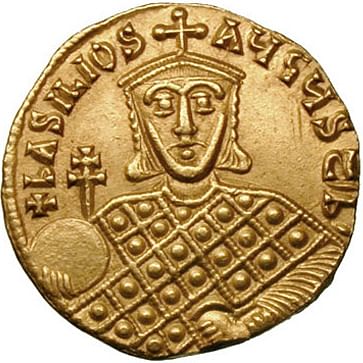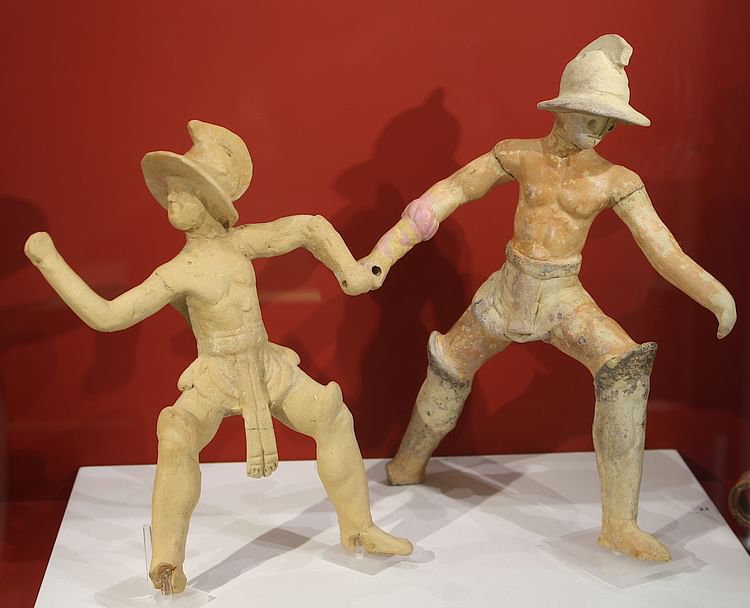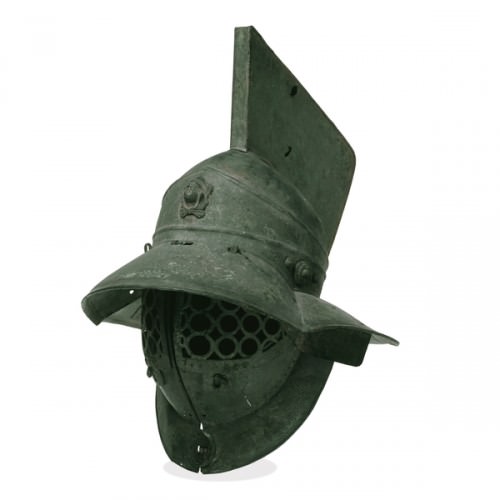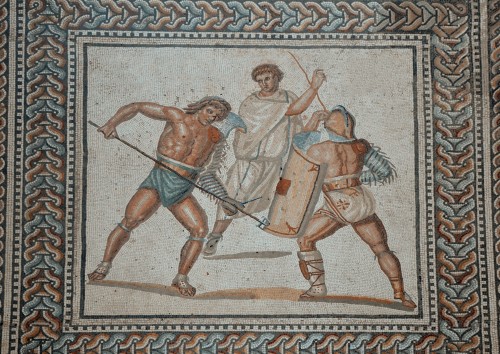Basil I › Roman Gladiator » Ancient origins
Articles and Definitions › Contents
- Basil I › Who Was
- Roman Gladiator › Antique Origins
Ancient civilizations › Historical and archaeological sites
Basil I › Who Was
Definition and Origins

Basil I was emperor of the Byzantine Empire from 867 to 886 CE and he founded the "Macedonian" dynasty which lasted for over 200 years. Basil was an Armenian from a humble background who had risen to become the second most powerful man in the realm. When he outrageously killed his benefactor and emperor, Michael III, he became number one in Constantinopleand oversaw a golden period in Byzantine history. Losing his throne in the same way he had gained it, Basil was succeeded by his son Leo VI in 886 CE.
CO-EMPEROR WITH MICHAEL III
Michael III, also known as “Michael the Drunkard” by his detractors, was emperor of the Byzantine Empire from 842 to 867 CE. His reign saw many military successes, especially in the east but the young ruler, later known for his love of wine and song, made the fateful decision to befriend and promote a certain uncouth Armenian known as Basil the Macedonian. Basil had probably never set foot in Macedon and his epithet seems to have derived from him having spent time with a group of prisoners of that region when he was captured by Krum, king of the Bulgars. He was from a peasant Armenian family who had relocated to Thrace but his life would be a classic rags-to-riches story.
MICHAEL III WAS WARNED THAT BASIL WAS A “LION WHO WOULD DEVOUR THEM ALL”.
Leaving his family, Basil sought his fortune in the metropolis of Constantinople and he certainly found it. Known as a talented wrestler and horseman, Basil's skills led him to be put in charge of the imperial stables - Michael was a keen charioteer - and from there, when spotted by the emperor, he was made Guardian of the Imperial Bedroom ( parakoimomenos ). In his new role Basil removed, by any means he saw fit, the enemies of the emperor. By far the biggest name to be targeted was Bardas, uncle of Michael and the chief minister responsible for much of the empire's success. Bardas was rightly suspicious of the Armenian interloper but was reassured by a solemn promise from both Basil and Michael that they had no ill-feeling towards him, an oath said to have been signed in the blood of Jesus Christ - a relic housed in the Church of St. Sophia. Basil, being illiterate, could only mark the document with an X.
Despite the promises, Basil went right on ahead and personally murdered Bardas in 865 CE. The dead general had clearly not heeded his own warning to Michael years earlier that the Armenian was a “lion who would devour them all” (Brownworth, 165).The murder was indicative of the lengths Basil would go to feed his ambition: no one was to stand in his way.

Michael III Crowns Basil Co-emperor
Michael and Basil had a complex, ill-defined and much-debated relationship with Eudokia Ingerina, Michael's mistress - Basil actually marrying her, but this may have been a ruse on Michael's part to have his mistress close at hand in the palace. What is even more extraordinary, in 866 CE Michael made Basil co-emperor ( basileus ) in a lavish ceremony in the Church of St. Sophia, likely as thanks for removing Bardas, now officially recorded as a traitor. Michael had the following statement read out at the coronation:
It is my will that Basil, the High Chamberlain, who is loyal to me, who has delivered me from my enemy and who holds me in great affection, should be the guardian and manager of my Empire and should be proclaimed by all as basilieus. (Norwich, 150)
SOLE EMPEROR
In the first year of his reign Basil reinstated Ignatios as the Patriarch of Constantinople (bishop). This decision improved relations with the papacy who had protested vehemently at the appointment of Photios for that position, then a layman, by Michael III. Basil was probably motivated by the need for Papal military support in Italy where Byzantine armies were busy battling the Arabs. Certainly, there was no personal issue with Photios who Basil was happy to employ as his children's tutor.Photios, in any case, got his old job back as bishop when Ignatios died in 877 CE, this time endorsed by Pope John VIII in a show of reconciliation with the Eastern Church. Photios did much to promote the study of Classical Greek and Roman literature, and he wrote some of the earliest surviving book reviews.
Ultimately, Basil did reconquer southern Italy, thanks to help from the Franks, although a notable fail was the loss of Syracuse in Sicily in 878 CE. Early in his reign Basil had seen the loss of Malta to the Arabs but a massive investment in modernising and strengthening the Byzantine navy paid dividends. Basil could call on the gifted admiral Nicetus Ooryphas, who gave his new ruler a victory against the infamous Cretan pirates, catching them on the hop by crossing the narrow isthmus of Corinth. Successes against the crumbling Arab caliphate empire were enjoyed in Cyprus, mainland Greece, and Dalmatia. Basil's armies won victories against the Paulicians in Asia Minor, too, sacking their capital at Tephrike, and moved deeper into central Asia along the Euphrates River.
PUBLIC BUILDINGS, MONUMENTS & WALLS ACROSS THE CAPITAL WERE GIVEN A MUCH-NEEDED REVAMP AFTER YEARS OF NEGLECT & DAMAGE BY EARTHQUAKES.
Back home, Basil got on with the task of governing and, if the official records are to be believed, he was especially keen to improve the lot of the poor, promote the arts in Constantinople and generally make his capital look worthy of its status. He is credited with building the Nea Ekklesia (“New Church”) on the grounds of the royal palace in 880 CE. The church was magnificent with five gilded domes, exotic marble on the inside, silver decorations on the outside, two fine fountains and bells shipped in from Venice. Unfortunately for modern tourists, the church blew up in 1453 CE after the Turks had been using it as a gunpowder store. Even more sumptuous was Basil's new palace, the Kainourgion. It had fine mosaic flooring depicting giant eagles, wall -paintings, eight columns of green stone and eight of onychite (a type of marble), and a throne room with a ceiling made from glass mosaic and solid gold filling. There was a half-dome at one end of this room with a giant painting of Basil and adoring generals presenting the emperor with a symbol from each city that his armies had conquered.
Public buildings, monuments and walls across the capital were also given a much-needed revamp after years of neglect and damage by earthquakes, notably the Church of St. Sophia which was in serious danger of toppling after a quake in 869 CE.Sadly, none of Basil's achievements in making Constantinople one of the great city's of the world still stands today.

Basil I & Leo VI Confront Each Other
Perhaps more useful to his people than architectural embellishments was Basil's determination to completely overhaul Byzantine law. During his reign a vast number of new laws were introduced in the greatest flurry of legal activity since the reign of Justinian (r. 527-565 CE). Indeed, Justinian's code was the primary target of Basil's updated revisions which also ordered laws by subject for easier future reference. Much of the emperor's new legislation - written in Greek and not Latin, as before, and known collectively as the Basilika - was ultimately encapsulated in two handbooks, the Procheiron and Epanagogue, designed to be of use to judges and lawyers.
BASIL & LEO
Basil had two heirs: Constantine, the eldest, who was from his first marriage and Leo, who was from his marriage with Eudokia. It had become customary for emperors to crown their son and chosen heir as co-emperor, even when still a child but Basil went one better and crowned both his sons, Constantine in 869 CE and Leo in 870 CE. To Basil's great distress Constantine died prematurely of unknown causes in September 879 CE, a blow from which the emperor never fully recovered and which caused him to largely withdraw from public life.
Basil's relationship with his second-choice heir was a troubled one. Leo, forced to marry a girl of his father's choosing - the pious Theophano - had acquired himself a mistress named Zoe Zautsina whom, naturally, his father disapproved of. Basil tried, unsuccessfully, to break the relationship by banishing the girl and making his son a virtual prisoner in a wing of the royal palace. Beaten, imprisoned and threatened with blinding, it is perhaps no wonder that Leo might have borne a grudge which would one day prove fatal for his father.
DEATH & LEGACY
Basil died in 886 CE. The cause, according to official records, was a hunting accident. The tale was a tall one involving the 74-year old emperor being dragged an improbable distance through the woods by a stag and then rescued by a group led by Zoe's father. It seems much more likely that Leo arranged for his father to be helped off his throne. It was a final irony and a sweet revenge from beyond the grave by Michael III that Basil's successor would be Leo, widely rumoured to actually have been the son of Michael. It is, perhaps, significant that one of the first acts of the new 19-year old emperor, now Leo VI (r. 886-912 CE), was to exhume Michael III's body from his nondescript grave and entomb him in a fine marble sarcophagus in the Church of the Holy Apostles.
Whatever the exact lineage, Basil's successors, the “Macedonian” emperors, made special efforts to whitewash the more unsavoury elements of the dynastic founder's reign. Basil's grandson, Constantine VII (r. 913-959 CE), was especially keen not to have any tarnish spread to his own image. Consequently, he wrote the biographical Vita Basilii which became the accepted historical record of Basil's life and achievements where the one-time wrestler is presented as one of the great emperors of Byzantium.
This article was made possible with generous support from the National Association for Armenian Studies and Researchand the Knights of Vartan Fund for Armenian Studies.
Roman Gladiator › Antique Origins
Definition and Origins

A Roman gladiator was an ancient professional fighter who specialised with particular weapons and armour. They fought before the public in organised games held in large purpose-built arenas throughout the Roman Empire from 105 BCE to 404 CE (official contests). As fights were usually to the death, gladiators had a short life expectancy and so, although it was in some respects a glamorous profession, the majority of fighters were slaves, former slaves or condemned prisoners. Without doubt, gladiator spectacles were one of the most watched forms of popular entertainment in the Roman world.
ETRUSCAN ORIGINS
The Romans were influenced by their predecessors in Italy, the Etruscans, in many ways. For example, in the use of animal sacrifice for divining the future, the use of the symbolic fasces and organising gladiatorial games. The Etruscans associated these contests with the rites of death and so they had a certain religious significance. Although the first privately organised Roman gladiator contests in 264 BCE were to commemorate the death of a father, the later official contests discarded this element. Vestiges of the religious origins did, however, remain in the act of finishing off fallen gladiators. In this case an attendant would strike a blow to the forehead of the injured. The attendant would wear a costume representing Hermes the messenger god who escorted souls to the underworld or Charun (the Etruscan equivalent). The presence of the divine Emperor himself, accompanied by priests and the Vestal Virgins also lent a certain pseudo-religious air to the contests.
GLADIATOR GAMES WERE A BLOODY ENTERTAINMENT & THE GLADIATOR CONTESTS WERE LITERALLY A MATTER OF LIFE & DEATH.
KINGS OF ENTERTAINMENT
Roman gladiator games were an opportunity for Emperors and rich aristocrats to display their wealth to the populace, to commemorate military victories, mark visits from important officials, celebrate birthdays or simply to distract the populace from the political and economic problems of the day. The appeal to the public of the games was as bloody entertainment and the fascination which came from contests which were literally a matter of life and death. Hugely popular events were held in massive arenas throughout the Empire, with the Colosseum (or Flavian Amphitheatre ) the biggest of them all. Thirty, forty or even fifty thousand spectators from all sections of Roman society flocked to be entertained by gory spectacles where wild and exotic animals were hunted, prisoners were executed, religious martyrs were thrown to the lions and the stars of the show, symbols of the Roman virtues of honour and courage, the gladiators, employed all their martial skills in a kill or be killed contest. It is a popular misconception that gladiators saluted their emperor at the beginning of each show with the line: Ave imperator, morituri te salutant! (Hail emperor, we who are about to die salute you!), whereas, in reality this line was said by prisoners about to be killed in the mock naval battles ( naumachia ), also held in the arenas on special occasions.

Gladiator relief
Gladiators most often came from a slave or criminal background but also many prisoners of war were forced to perform in the arenas. There were also cases of bankrupt aristocrats forced to earn a living by the sword, for example Sempronius, a descendent of the powerful Gracchi clan. It is also of note that until their outlaw by Septimius Severus in 200 CE, women were permitted to fight as gladiators. There were special gladiator schools set up throughout the Empire, Rome itself had three such barracks and Capua was particularly famous for the gladiators produced there. Agents scouted the empire for potential gladiators to meet the ever-increasing demand and fill the training schools which must have had a phenomenal turnover of fighters. Conditions in the schools were similar to any other prison, small cells and shackles for all, however, the food was better (eg fortifying barley) and trainees received the best possible medical attention; they were, after all, an expensive investment.
THE THRACIAN GLADIATOR HAD A CURVED SHORT SWORD (SICA) & A VERY SMALL SQUARE OR ROUND SHIELD (PARMA).
ARMOUR & WEAPONS
The term gladiator derives from the Latin gladiatores in reference to their principal weapon the gladius or short sword.However, there were a wide range of other weapons employed in gladiator contests. The gladiators also wore armour and their helmets, in particular, were objects of great workmanship, richly embossed with decorative motifs and set with ostrich or peacock plumed crests. Weapons and armour though depended on which class a gladiator belonged to. There were four principal classes:
- The Samnite
- The Thracian
- The Myrmillo
- The Retiarius
The Samnite class was named after the great Samnite warriors that Rome had fought and beaten in the early years of the Republic. Interestingly, the Romans, at least in the early days, used gladiator and Samnite as synonyms, suggesting an alternative origin to Etruscan for these contests. The most heavily armed, the Samnite had a sword or lance, a large square shield ( scutum ) and protective armour on his right (sword) arm and left leg. The Thracian gladiator had a curved short sword ( sica ) and a very small square or round shield ( parma ) held in the fist to deflect blows. The Myrmillo gladiator was sometimes known as the fishman as he had a fish-shaped crest on his helmet. Like the Samnite, he carried a short sword and scutum but had armour only of padding on arm and leg. The Retiarius had no helmet or armour other than a padded shoulder piece and he carried a weighted net. He would try to entangle his opponent by throwing the net and then stab with his trident.
Gladiators fought in particular combinations, usually to provide a contrast between slower, more heavily armoured classes such as the Myrmillo against quicker, less protected gladiators such as the Retiarius. There were many other lesser types of gladiators with various combinations of weapons and armour and names changed over time, for example, 'Samnite' and ' Gaul' became politically incorrect when these nations became allies. Other types of combatants also included archers, boxers and the bestiarii who fought animals in the wild beast hunts.

Samnite Gladiator Helmet
WINNERS & LOSERS
Those who lacked enthusiasm to fight were cajoled by their manager ( lanista ) and his team of slaves who brandished leather whips or red-hot metal bars. No doubt the indignant roars from 40,000 spectators and the unrelenting attacks of one's opponent also convinced many to fight till the end. There were cases of refusal to fight: Perhaps one of the more famous was in the gladiator games organised by Quintus Aurelius Symmachus in c. 401 CE when the Germanic prisoners who were scheduled to fight decided instead to strangle each other in their cells rather than provide a spectacle for the Roman populace.
The losing gladiator, if not killed outright, often appealed for mercy by dropping his weapon and shield and raising a finger. His adversary could then decide to be lenient, although, as there was a significant risk of meeting again in the arena, it was considered good professional practice to kill your opponent. If the emperor were present then he would decide, although the crowd would certainly try to influence his judgement by waving cloths or gesturing with their hands - raised thumbs and shouts of Mitte! meant 'let him go', thumbs down ( pollice verso ) and Iugula! meant execute him.
Victors in the contests, particularly those with many fights behind them, became darlings of the crowd and as surviving graffiti on Roman buildings indicates, they were particularly popular with women - cases of affairs with aristocratic ladies and even elopement were not unknown. Graffiti from Pompeii gives a fascinating insight into how the gladiators were seen by the general public: Oceanus 'the barmaid's choice' or another was described as decus puellarum, suspirium puellarum (the delight and sighed-for joy of girls) and also written were how many victories some attained: Petronius Octavius 35 (his last), Severus 55, Nascia 60. However, it should be noted that the average was much lower and there were even some games in which victors fought other winners until only one gladiator was left standing. More material rewards for winning one's contest included the prestigious palm branch of victory, often a crown, a silver dish heaped with prize money and perhaps, after years of victories, even freedom.

Roman Gladiator Mosaic
EMPEROR COMMODUS (108-192 CE) WAS KEEN & MAD ENOUGH TO COMPETE HIMSELF IN THE GLADIATOR ARENA.
FAMOUS GLADIATORS
Perhaps the most famous gladiator of all was Spartacus, who led an uprising of gladiators and slaves from Capua, the leading producer of gladiators, in 73 BCE. From Thrace, the former Roman soldier had become a bandit until his capture and forced training as a gladiator. He and seventy comrades escaped from their training school and set up a defensive camp on the slopes of Vesuvius. Besieged, they then fled their position and rampaged through the countryside of Campania, collecting followers as they went and moulding them into an efficient fighting force. Battling his way north to the Alps, Spartacus displayed great military leadership in defeating four Roman armies on no less than nine occasions. Far from being a saint though, when a friend died in battle, Spartacus, in the old custom, arranged for three hundred Roman prisoners to fight gladiator contests in honour of his fallen comrade. After two years of revolt, the armies of Marcus Licinius Crassus finally cornered and quashed the rebels in Apulia in the south of Italy. As a warning to others, 6,000 of the prisoners were crucified along the Appian Way between Capua and Rome. Another consequence of this disturbing episode was that from then on, the number of gladiators owned by private citizens was strictly controlled.
Another famous gladiator was in fact a non-professional. Emperor Commodus (108-192 CE) was keen and mad enough to compete himself in the arena, indeed, there were even rumours that he was the illegitimate son of a gladiator. One might argue that Commodus was a professional as he made sure to draw a fantastic salary for his appearances in the Colosseum.However, it is unlikely that Commodus, usually dressed as Mercury, was ever in any real danger during the hundreds of contests he fought in the arena and his most frequent participation was as a slaughterer of wild animals, usually from a protected platform using a bow.

Commodus
THE END OF THE SHOW
Gladiator contests, at odds with the new Christian-minded Empire, finally came to an end in 404 CE. Emperor Honorius had closed down the gladiator schools five years before and the final straw for the games came when a monk from Asia Minor, one Telemachus, leapt between two gladiators to stop the bloodshed and the indignant crowd stoned the monk to death.Honorius in consequence formally prohibited gladiatorial contests, although, condemned criminals continued the wild animal hunts for another century or so. Many Romans no doubt lamented the loss of a pastime that was such a part of the fabric of Roman life but the end of all things Roman was near, for, just six years later, the Visigoths led by Alaric would sack the Eternal city itself.
LICENSE:
Article based on information obtained from these sources:with permission from the Website Ancient History Encyclopedia
Content is available under License Creative Commons: Attribution-NonCommercial-ShareAlike 3.0 Unported. CC-BY-NC-SA License